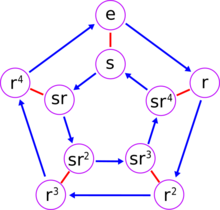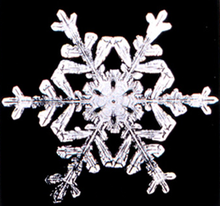
This
snowflake has the symmetry group of a regular hexagon
In group theory , the dihedral group is explained as a semi-direct product (see below ) and therefore contains exactly the elements. For this group is isomorphic to the isometric group of a regular polygon in the plane. It is then non-Abelian and contains rotations and mirror images . Its name is derived from the word Dieder (hyphenation: Di-eder, pronunciation [ diˈeːdər ]) ( Greek : two-sided) for regular corner. These groups occur frequently in geometry and group theory, are generated by two reflections (elements of the order ) and are therefore the simplest examples of Coxeter groups .








Designations
There are two different names for dihedral groups. In geometry one usually writes in order to underline the connection with the regular corner. In group theory one often writes to instead order emphasized. However, this ambiguity can easily be resolved with an explanatory addition. In this article stands for the dihedral group with elements.






definition
The dihedral group can be defined for as the isometric group of a regular corner in the plane. This consists of rotations and reflections, so it has a total of elements. The isometries are also known as symmetry transformations. The successive execution of symmetry transformations is used to link the group .







In cases and , however, the geometric definition leads to other groups. Therefore, the algebraic definition via the semidirect product is to be preferred here (the operation from to through inversion is given in the semidirect product ). This algebraic definition applies to everyone .






Examples
An example is the dihedral group of congruence maps of an equilateral triangle on itself, which is isomorphic to the symmetric group . is accordingly the symmetry group of the square under reflections and rotations.



 is isomorphic to Klein's group of four and is the symmetry group (consisting only of the two reflections, the rotation by 180 ° and the identity) of the four corners of a square, in which only the right and left side are drawn (i.e. two two-corners). is the symmetry group of a two-sided.
is isomorphic to Klein's group of four and is the symmetry group (consisting only of the two reflections, the rotation by 180 ° and the identity) of the four corners of a square, in which only the right and left side are drawn (i.e. two two-corners). is the symmetry group of a two-sided.

 is also the symmetry group of a non- equilateral rectangle or a non- equiangular diamond. is also the symmetry group of an isosceles triangle that is not equilateral.
is also the symmetry group of a non- equilateral rectangle or a non- equiangular diamond. is also the symmetry group of an isosceles triangle that is not equilateral.

The following graphic illustrates the dihedral group using the rotations and reflections of a stop sign: The first line shows the eight rotations, the second line the eight reflections.


Matrix representation
We consider a flat, regular corner. We choose its center point as the zero point of a coordinate system, any of its symmetry axes as the -axis and the normal to it (in the usual orientation, so that a right system results) as the -axis. The dihedral group can then easily be represented as a matrix group. For this purpose, the rotation around the angle and the reflection on the straight line , which is inclined at an angle to the positive axis. These transformations are then written as matrices as follows:














The following relationships stand out:
-
 and . Therefore we can limit ourselves to .
and . Therefore we can limit ourselves to .

-
 , the rotation around the angle , is the identity.
, the rotation around the angle , is the identity.
-
 is the rotation around the angle and it applies to everyone .
is the rotation around the angle and it applies to everyone .


-
 is the reflection on the -axis and it applies to everyone .
is the reflection on the -axis and it applies to everyone .


If is odd, then each of the mirror axes goes through a corner point and the midpoint of the opposite side. For straight lines , on the other hand, there are two types of mirror axes, with two opposite corner points or with two opposite side centers.



In this representation, for example, the eight elements of the dihedral group are written as follows:


These rotations and reflections can be represented graphically as follows:
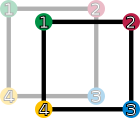
 (Rotation by 0 °) (Rotation by 0 °) |
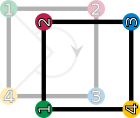
 (Rotation by 90 °) (Rotation by 90 °) |

 (Rotation by 180 °) (Rotation by 180 °) |

 (Rotation by 270 °) (Rotation by 270 °)
|
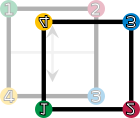
 (Reflection on the x-axis) (Reflection on the x-axis) |
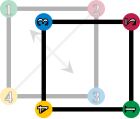
 (Reflection on the diagonal y = x) (Reflection on the diagonal y = x) |
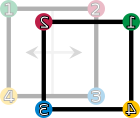
 (Reflection on the y-axis) (Reflection on the y-axis) |
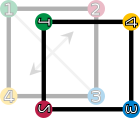
 (Reflection on the diagonal y = -x) (Reflection on the diagonal y = -x)
|
| Rotations and reflections of a square. The four corners are numbered and colored to illustrate the transformation.
|
Permutation representation
Let us first consider the dihedral group as an example . This operates through symmetry transformations on a square as shown in the previous graphic. If you look at the action of the dihedral group on the corner points , you get a faithful representation in the symmetrical group , i.e. an injective group homomorphism . More precisely, the transformations on the corners act as the following permutations:






In general, the operation of the dihedral group on the corner points defines a true representation . In the above notation, for example, one obtains the permutation




In cycles of writing this is the cyclic permutation , the on maps, on so on, until finally on being imaged. The further rotations are obtained from this using the relation for all . For the mirroring on the axis of symmetry through one receives accordingly in cycle notation










with the Gaussian integer function (which assigns every real number the largest integer that is not greater than ). The other reflections are obtained from this by means of the relation for all (with ).






Generators and Relations
All rotations are generated by. These form a cyclical subgroup of the order and therefore of the index . You get the whole group by adding any reflection, for example , and so the presentation






where is the neutral element of the group.

The concatenation of two reflections is a rotation. If the angle is between the two mirror axes , this linkage is a rotation around the angle . This means that the dihedral group is generated by two adjacent reflections, for example and . This is how you get the presentation






This is the simplest case of a Coxeter group .
For all indices and also applies:






The indices are considered modulo ( and ).



Applications
geometry
Dieder groups are the simplest examples of reflection groups. These play an important role in classical geometry , for example in the classification of regular polyhedra. In dimension here, dihedral groups correspond to the regular polygons.

Coding
The numerical linkage defined by the above permutations is used in checksum procedures as an alternative to various modulo-based procedures. For example, the German banknotes had Dieder checksums.
See also
Web links
Individual evidence
-
^ Jörg Michael: Pure flowers. Check digit procedure on the basis of dihedral groups. In: c't 4/1997. P. 448.












































































